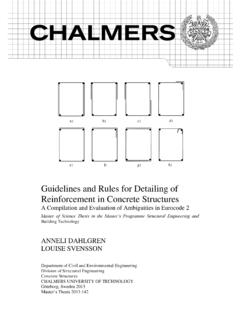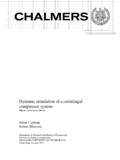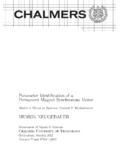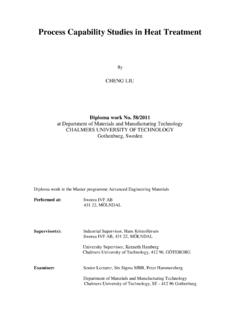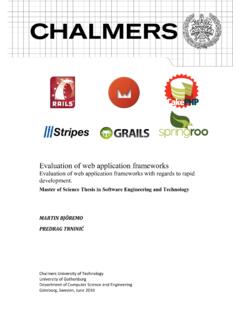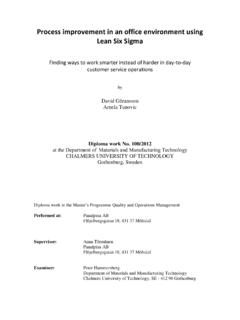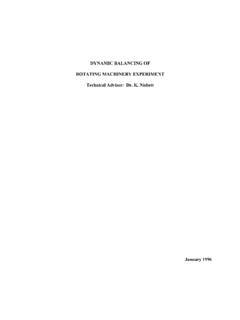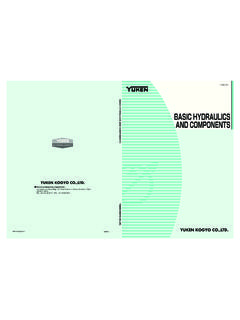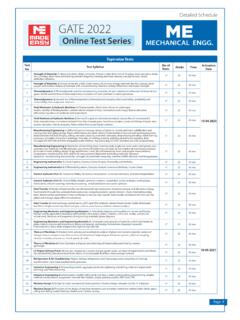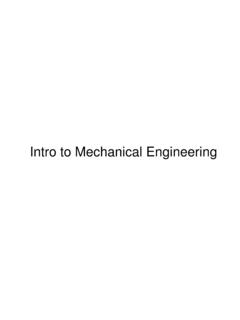Transcription of Design, construction and verification of a self-balancing ...
1 design , construction and verification of a self- balancing vehicle Mikael Arvidsson Jonas Karlsson Department of Signals and Systems Chalmers University of Technology G teborg, Sweden, 2012 EX050/2012. A bstract The Segway Personal Transporter is a small footprint electrical vehicle designed by Dean Kamen to replace the car as a more environmentally friendly transportation method in metropolitan areas. The dynamics of the vehicle is similar to the classical control problem of an inverted pendulum, which means that it is unstable and prone to tip over. This is prevented by electronics sensing the pitch angle and its time derivative, controlling the motors to keep the vehicle balancing (1). This kind of vehicle is interesting since it contains a lot of technology relevant to an environmentally friendly and energy efficient transportation industry.
2 This thesis describes the development of a similar vehicle from scratch, incorporating every phase from literature study to planning, design , vehicle construction and verification . The main objective was to build a vehicle capable of transporting a person weighing up to 100 kg for 30 minutes or a distance of 10 km, whichever comes first. The rider controls are supposed to be natural movements; leaning forwards or backwards in combination with tilting the handlebar sideways should be the only rider input required to ride the vehicle. The vehicle was built using a model-based control design and a top-down construction approach. The controller is a linear quadratic controller implemented in a 100 Hz control loop, designed to provide as fast response to disturbances as possible without saturating the control signal under normal operating conditions.
3 The need for adapting the control law to rider weight and height was investigated with a controller designed for a person 1,8 m tall weighing 80 kg. Simulations of persons having weights between 60-100 kg and heights between 1,6-1,9 m were performed, showing no need to adapt the controller. The controller could safely return the vehicle to upright positions even after angle disturbances of 6 degrees, the highest angle deviation considered to occur during operation. A cknow ledgm ents This project was funded and supported by Epsilon, at the department Embedded Systems. Naturally in these kind of projects one comes in contact with a lot of enthusiastic and skilled people, sharing their knowledge and ideas. This has been a great resource and therefore we would like to thank some of those who have been especially helpful and inspiring.
4 The members of the Chalmers society X-P for their help and consultation when the mechanical parts in the workshop was made, a special thanks to Niklas Tolleson for his workshop lectures. The members in Chalmers robotics society for their consultation regarding microcontroller programming, especially Benjamin Vedder with his expertise in the XMEGA microcontroller. Finally we want to thank our supervisors; Torsten Wik at Chalmers, Kalle Lindbeck and G ran Kvick at Epsilon. N om enclature SOC - state of charge IMU - inertial measurement unit RTOS - real time operating system OSMC - open source motor controller UART - universal asynchronous receiver/transmitter ADC - analogue to digital converter IC - integrated circuit MEMS - microelectromechanical systems MPU - motion processor unit DMP - digital motion processor LED - light emitting diode IIR - infinite impulse response LQ - linear quadratic LQR - linear quadratic regulator MOSFET - metal oxide semiconductor field-effect transistor EEPROM - electrically erasable programmable read-only memory PWM - pulse width modulation I2C - inter-integrated circuit L IST OF FIG U R ES.
5 FIGURE 1 - STATE FEEDBACK .. 8. FIGURE 2 - LGQ CONTROLLER .. 10. FIGURE 3 - QUADRATURE SIGNALS .. 14. FIGURE 4 - DESCRIPTION OF THE COORDINATE SYSTEM AND ANGLES. THE FIGURES COME. FROM (8).. 16. FIGURE 5 - OPEN LOOP RESPONSE WITH INITIAL ANGLE OF -6 21. FIGURE 6 - CLOSED LOOP SYSTEM RESPONSE WITH THE SYSTEM AT REST, WITH AN INITIAL. PITCH ANGLE DISPLACEMENT OF 6 DEGREES. THE CONTROL SIGNAL IS SLIGHTLY. SATURATED IN THE BEGINNING OF THE SIMULATION.. 25. FIGURE 7 - THE AVERAGE wheel ANGLE AND ANGULAR VELOCITY, SAME SIMULATION AS. FIGURE 5.. 25. FIGURE 8 - LID OPEN SHOWING THE MAIN CIRCUIT BREAKER AND THE CHARGER PLUG .. 28. FIGURE 9 - OVERVIEW OF THE ELECTRICAL SYSTEM .. 29. FIGURE 10 - OVERVIEW OF THE SOFTWARE SYSTEM, ALL MODULES COMMUNICATE.
6 THROUGH SERIAL INTERFACES ..30. FIGURE 11 - CAD IMAGE OF THE 31. FIGURE 12 - EXPLODED VIEW FROM CAD MODEL OF THE HANDLEBAR HEIGHT ADJUSTMENT. COMPONENTS; THE CLAMP, THE PLASTIC SLEEVE AND THE LOWER POLE..32. FIGURE 13 - INSIDE THE CHASSIS. THE CIRCUIT BOARDS ARE SCREWED TO PLASTIC SHELVES. MOUNTED ON TOP OF EACH OTHER. THE POWER BOARD AND THE wheel SENSOR. BOARD ARE COVERED BY THE TOP SHELF WHICH HAS THE MAIN PROCESSING BOARD. 34. FIGURE 14 - EXPLODED CAD VIEW OF THE POWERTRAIN, SHOWING THE MOTORS WITH THE. ATTACHED GEARBOX, CONNECTOR HUB AND THE FIGURE 15 - PWM SIGNAL ..37. FIGURE 16 - MOTOR CONTROLLER ..37. FIGURE 17 - THE SELECTED wheel , A 19" wheel WEIGHING 4,6 KG ..38. FIGURE 18 - POWER BOARD PROGRAM FLOWCHART .. 40. FIGURE 19 - IMPLEMENTED TASKS IN THE MAIN PROCESSING SYSTEM.
7 HIGHER NUMERIC. PRIORITY MEANS HIGHER PRIORITY .. 42. FIGURE 20 - STATE machine HANDLING UART PACKET RECEPTION ..43. FIGURE 21 THE DRIVERS TAB WHICH UPDATES EVERY 50 MS WITH NEW INFORMATION. FROM THE VEHICLE. RIDER MODE' IS A SWITCH THAT ACTIVATES THE CONTROLLER. 45. FIGURE 22 - THE SETTINGS TAB WHICH MAY BE USED TO READ AND UPDATE CONTROL. PARAMETERS AS WELL AS TURNING ON AND OFF THE DEBUG MODE AND MOTORS .. 45. FIGURE 23 - THE MAP TAB SHOWING THE VEHICLE AND A BLUE LINE FOR DIRECTIONS. TOWARD THE DESTINATION .. 46. FIGURE 24 - DIAGRAM OVER MPU-6050 INTEGRATION WITH APPLICATION PROCESSOR. THE. COMPASS IS OPTIONAL (IMAGE FROM , RETRIEVED 9TH MAY. 2012).. 47. FIGURE 25 - EVENT SYSTEM ON THE XMEGA MICROCONTROLLER (IMAGE FROM. , RETRIEVED 10TH JUNE 2012).
8 49. FIGURE 26 - FRICTION COMPENSATION STRATEGY, THE TOTAL CONTROL SIGNAL IS MADE. UP OF TWO PARTS; THE CONSTANT FRICTION COMPENSATION AND THE ACTUAL. CONTROL SIGNAL.. 50. FIGURE 27 COMPARISON OF REFERENCE ANGLE VALUE FROM POTENTIOMETER AND THE. ANGLE MEASURED BY THE 54. FIGURE 28 - BODE DIAGRAM OF THE 1ST ORDER BUTTERWORTH FILTER .. 55. FIGURE 29 - FILTERED AND UNFILTERED ANGULAR RATE .. 56. FIGURE 30 - RAW STEERING SIGNAL DURING A DRIVING 57. FIGURE 31 - FILTERED AND UNFILTERED STEERING SIGNAL WITH REMOVED OUTLIERS .. 58. FIGURE 32 - CURRENT DRAWN FROM BATTERY DURING A STRESS 59. FIGURE 33 - DRIVING TEST OF THE VEHICLE .. 59. FIGURE 34 CONTROLLER RESPONSE FOR RIDERS OF DIFFERENT 60. FIGURE 35 - CONTROLLER RESPONSE FOR RIDERS OF DIFFERENT HEIGHTS.
9 61. FIGURE 36 - CONTROLLER RESPONSE FOR RIDERS AT THE ENDPOINTS OF THE. INVESTIGATED INTERVAL .. 61. Table of contents 1 IN TR OD U C TIO N .. 1. BACKGROUND .. 1. PURPOSE .. 2. DELIMITATIONS .. 3. METHOD .. 3. Preliminary modelling and investigation of the dynamical system .. 4. Mechanical and electrical design .. 4. Software design .. 5. Selection of main components .. 5. Testing and verification .. 5. 2 TH EOR Y .. 6. MODELLING BASED ON ENERGY THE LAGRANGIAN METHOD .. 6. CONTROL STRATEGIES .. 7. PID-controller .. 7. State feedback .. 8. Optimal control .. 9. REAL WORLD SENSOR BEHAVIOUR .. 11. Accelerometer .. 11. Gyroscope .. 12. Sensor fusion algorithms .. 12. Quadrature encoders .. 13. 3 M OD ELLIN G A N D SIM U LA TIO N S.
10 15. MATHEMATICAL MODEL .. 15. Model parameters .. 15. Nonlinear model .. 16. Linear model .. 20. Open-loop test of nonlinear and linear model .. 21. 4 C ON TR O LLER D ESIG N .. 22. CONTROL STRATEGY USING THE ERROR TO GET 22. DISCRETE TIME LQ-CONTROLLER design .. 22. Controller specification .. 23. Model discretization and LQ cost matrices .. 23. CLOSED LOOP SYSTEM RESPONSE SIMULATIONS .. 24. 5 OV ER V IEW OF TH E V EH IC LE .. 27. MECHANICAL OVERVIEW .. 27. ELECTRICAL OVERVIEW .. 28. P OW ER SO U R C E, A 480 W H LIFEP O 4 B A TTER Y .. 29. SOFTWARE OVERVIEW ..30. 6 SU B SY STEM D ESIG N A N D IM P LEM EN TA TIO N .. 3 1. HANDLEBAR .. 31. Handlebar design .. 31. Handlebar implementation .. 32. Chassis design .. 33. Chassis implementation.

